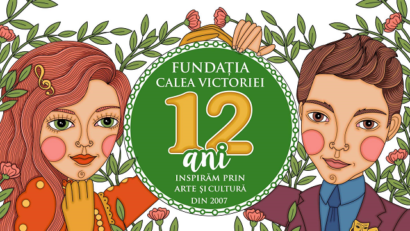Appealing Toys: Miniature Replicas of Brancusi’s Works
The city of Targu Jiu in south-western Romania plays host to the works of Romanian-born sculptor Constantin Brancusi: The Endless Column, the Gate of the Kiss, the Alley of the Chairs and the Table of Silence.

România Internațional, 13.07.2014, 12:34
The city of Targu Jiu in south-western Romania plays host to the works of Romanian-born sculptor Constantin Brancusi: The Endless Column, the Gate of the Kiss, the Alley of the Chairs and the Table of Silence. Each work is carved in stone, the sole exception being the Endless Column, which is made up of bronze modules layered upwards, so that the monumental work reaches a height of nearly 30 meters. The initiators of a recently launched project, entitled Minitremu, have come up with the idea of bringing art closer to children and decided to create some miniature replicas of Brancusi’s works and turn them into appealing toys.
At first, the Gate of the Kiss was turned into a dental retainer. Then, the Endless Column was disbanded piece by piece, each bronze block being painted in a different colour and reinterpreted according to the imagination of the builder. Carved in lacquered wood, painted in catchy pastels, the miniature replicas of Constantin Brancusi’s works in Targu Jiu can now be seen as kids’ stuff. Gabriel Boldis, one of the initiators of the Minitremu project explains:
Gabriel Boldis: “Minitremu is an initiative by means of which art is brought closer to children. Back when I was a kid I only had access to art by means of guided tours, sprinkled with the usual ’don’t touch this’, ‘careful with that’ warnings. Otherwise, we only knew art through art albums, which you had to handle with great care. We’re trying to turn art into something tangible. Children feel the need to experiment, to touch and break things, to interact with the art objects. From that perspective, Minitremu is an attempt to take art out of the sacred realm and closer to child-like imagination. I came up with the idea while watching some kids play in the sandbox. Parents try to compensate their absence from their children’s lives through various objects such as expensive toys, which in theory delight the little ones. To this day there are children who play by themselves, without necessarily interacting with other children, although they are surrounded with all sorts of objects. At times like these we thought it would be OK for certain objects that don’t have any particular meaning for them to gain a more intense significance, somehow pushing parents into developing a relation with their children. And that’s where these toys step in”.
Minitremu is no premiere in the world of toys. Frank Lloyd Wright and Le Corbusier were raised with “gifts” from Froebel and other mind-stimulating toys. During her training at the legendary German school “Bauhaus”, Alma Siedhoff-Buschelh created a set of toys based on pedagogical principles, using primary colours, simple geometry and abstractions.
The bet of the artists involved in the Minitremu project with the Romanian parents was a winner. The sets of toys inspired by Brancusi’s works are expensive enough to draw the attention of those who decide to buy them. The toys are beautifully manufactured, have nice colors, rounded and polished edges and the lacquers used are not toxic. Each piece of wood is processed by hand and the toys are produced in small amounts following the placement of an order. Gabriel Boldis is back at the microphone:
Gabriel Boldis: “Brancusi’s work is monumental and through it we have access to metaphysical concepts: time, space, the axis mundi. What we did was to divide these concepts into segments and color them. Metaphorically speaking, it seems like children can touch time if they lay hands on the table of silence. At first sight, these toys do not mean anything, but put together, they acquire some meaning. The toys do not make children think of princesses and knights, actually they stir the kids’ imagination. We never suggested to children how to play with these toys. From what we have seen, they like touching the rounded, wooden forms and invariably build a column out of small chairs. I think children also find an aesthetic pleasure in combining colours. We have made everything out of an artistic perspective and now we are discovering the pedagogical value of these toys. And it’s obvious that children like to build and find a balance of things.”
In 2013 the artists of the Minitremu project started a fund-raising campaign that should have allowed them to produce 1,000 copies of each toy. The money would have led to a drop by half in the toys’ price, which would have helped the artists fulfill their goal: that of creating art for each and every child and not exclusivist toys. The campaign, run on the Indiegogo site, was aimed at raising donations worth 5 up to 250 dollars. Unfortunately, they did not raise the envisaged 17 thousand dollars but the campaign has brought them fame, says Gabriel Boldis.
Gabriel Boldis: “The campaign has been very successful because the people who accessed it shared the information they found, and this encouraged us to carry on, which is a success in itself. So, it’s no longer important if we manage to raise the intended money or not, the support we receive is much more important.”
The artists with the Minitremu project also intend to make toys inspired by other Romanian artists. In fact the first steps have already been taken in this respect, and a coloring book featuring the drawings of Romanian illustrator Dan Perjovschi has been published.






























